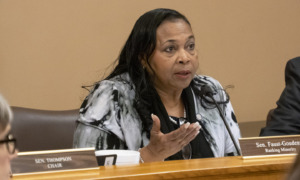With a rare victory over Washington’s education lobby, youth-serving agencies can for the first time directly tap into the federal government’s biggest pot of dedicated after-school funds.
Although the bulk of the reauthorized Elementary and Secondary Education Act (ESEA) is aimed at higher academic standards and accountability in classrooms, the $22.1 billion law also gives community based organizations (CBOs) expanded opportunities through reauthorization of the 21st Century Community Learning Centers (CLC), as well as through tutoring provisions, charter schools and dropout-prevention programs.
For the first time, CBOs – including public, private and faith-based groups – can apply directly to states for grants to conduct after-school programs under the CLC. Previously, school districts applied to the federal government for grants, and could partner with youth-serving organizations.
“This legislation moves us forward in a significant way,” said Martin Blank, staff director for the Coalition of Community Schools at the Institute for Educational Leadership. “If implemented effectively, it gives communities the option of identifying and selecting the lead organization that best meets the needs of the children.” That organization need not be a public school, although most programs are expected to remain school-based.
ESEA authorizes $1.25 billion in fiscal 2002 for the CLC program, although Congress appropriated an even $1 billion. The bill says CLC activities are intended to provide “academic enrichment.” States will receive funds based on the number of youth who qualify for federal assistance under Title I of the act.
CBOs have sought direct access to the CLC for years, but were outmaneuvered by the education lobby as recently as fall 2000. “Such diversion of funds would have undermined the program’s focus on learning and academic enrichment,” the 2.6 million-member National Education Association (NEA) said then.
Despite losing on that point this time, the teachers’ union claimed victory through restrictions placed on groups that win grants. The NEA was especially concerned about potential hiring discrimination by religious organizations that run after-school programs.
“The bill initially gave preference to religious discrimination and now bans it. NEA led the fight to demand this change,” said Becky Fleischauer, an NEA legislative and political affairs spokeswoman. “We didn’t oppose the change [in funding eligibility] because most of the programs are school-based and there is specific language concerning meeting transportation needs and collaborating with the school.”
Not everyone likes the new policy.
“The concern is that the programs being offered [should be] aligned with the goals and academics of the school,” said Reginald Felton, director of federal relations for the National School Boards Association. “If they’re not aligned, it will be difficult to measure their effectiveness. The law itself gives no role to the schools or districts to make an assessment of the program in the application process.”
Many youth program directors want to see what kind of community coalitions will evolve to provide after-school services, and how well schools will work with them.
“A defining thing for this program will be how the faith-based organizations approach the community-based organizations,” said Judy Samelson, executive director of the Flint, Mich.-based Afterschool Alliance. “There will be a broader group of stakeholders on after-school programs. No one group can do it alone and give the kids the best program.”
Parents, community groups and social service agencies will also be tapped for input and participation in several other activities under the new law, including student counseling programs, parent resource centers, plans to improve failing schools, teacher training, mentoring and English education.
“This notion of a community school is embedded in the legislation,” Blank said. “The issue here is to focus on the needs of young people. It’s not an argument between youth development and education.”
ESEA is the nation’s blueprint for federal support of education at the state and local level. Even with the law, the federal government provides only about 7 percent of the local education budget.
Between hearings and an unsuccessful attempt to reauthorize the act in the previous Congress, lawmakers spent more than three years working on the law. The provisions are detailed in an 1,100-page conference report drafted by House and Senate staffers.
Following are other highlights of ESEA, including those that most affect youth-serving organizations:
Safe and Drug-Free Schools Public and private entities will be able to apply directly to the state and federal governments for grants to run programs under this portion of the bill. Congress appropriated $650 million for 2002 for programs to combat school violence and drug and alcohol use, and to provide student enrichment programs.
Many congressional Republicans sought to eliminate dedicated funding for both drug-free and after-school programs, proposing instead a new block grant combining the two. Democrats objected and helped to defeat the proposal.
School Choice Another key change to previous law allows parents of poor children in consistently failing schools to use a portion of federal aid – again under Title I of the act – to seek supplemental services. The aid is expected to range from $500 to $1,000 per youth. Parents could choose services from a list of state-approved providers.
“It provides avenues for parents to pursue support that it appears is not available at the school,” said Mary Kayne Heinze, director of media relations for the Center for Education Reform. “It does provide parents some flexibility to help their children master the subjects.”
That provision is an obvious boon to organizations like Sylvan Learning Systems, the nation’s largest provider of supplemental services. The company looks “forward to partnering with schools, teachers, parents and students to help achieve the law’s mission of ensuring that ‘no child is left behind,’” said President Jeffrey Cohen.
This change is also a small victory for groups pushing for greater parental choice in public education. Those groups also count as a victory a provision that allows students in failing schools to transfer to another public school, including charters. Republican failed in their attempts to insert the ultimate tool for school choice – vouchers.
Charter Schools Choice options include transfers to charter schools, many of which are run by youth-serving organizations. The law authorizes a new program to help charter schools buy or build facilities, but only in states that already provide some financial assistance to charter schools on a per-pupil basis. The influx of federal money could help many potential charters secure facilities.
“It has the ability to help the charter movement in many states because it provides the initial startups,” said Heinze of the Center for Education Reform. “In other states, it may make the approval process a little easier,” she said, illustrating a Catch-22: Some states require charter applicants to have a facility before they are given permission to operate, but many applicants can’t get facilities until their charters are approved.
Congress appropriated $300 million overall for charter school programs in fiscal 2002.
Character Education Funding restrictions for character education programs were lifted by the law. Previously, only 10 states a year could receive federal grants for character education programs, with each state limited to $1 million. Now states and local educational agencies are eligible, with no restrictions on the number of awards or lifetime funding amounts.
Minimum grants of $500,000 will be awarded to states that form coalitions with local districts, or with local districts and community organizations. Program directors must demonstrate that their proposals have clear goals and objectives and are based on scientific research.
The law also establishes a national clearinghouse of information on model programs, material and curricula, and research findings.
Education Title I provides aid for the nation’s poorest children, and is the single largest education program in the nation. The fiscal year 2002 funding level of $10.4 billion is an increase of about 18 percent over 2001. Even that doesn’t cover every child who would qualify for assistance.
The law also provides nearly $1 billion for the Reading First initiative, designed to help all children learn to read. The initiative is a signature piece of President George Bush. He seized reauthorization and “reform” of the 1965 ESEA as his top domestic priority while he was on the campaign trail, and called his proposal the Leave No Child Behind Act of 2001.
Prayer, Scouts and the Military The new law includes several new rules for states, local districts and schools to receive federal funds.
The first requires a federal guide on constitutionally protected school prayer in public schools. Districts must certify to their state educational agencies that they have no policy that prevents constitutionally protected prayer, as determined by the guide.
Secondly, the Boy Scouts of America and other federally chartered “patriotic” organizations cannot be denied equal access to public schools because of membership criteria (such as no gays) or oaths of allegiance (such as to God).
In a similar vein, the act says military recruiters have the same right of access to high school students that is given to colleges and prospective employers. In addition, the military, by request, can get access to the names, addresses and telephone listings for high school students. Parents must be notified that the information cannot be released without their consent.






























